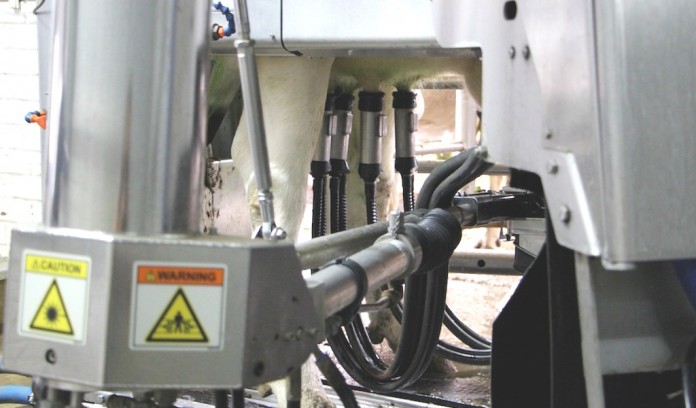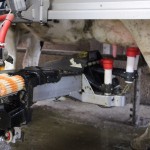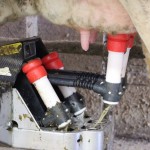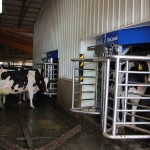
SALEM, Ohio — Robotic milkers are changing the way small family dairies manage their farms. When they first came on the scene roughly seven to eight years ago, producers were hesitant — wondering if they could trust the machine to milk their cows and if the cost was worth it. Today, as more small farms are taking on robotic milking systems — or thinking about it — cost is still a barrier, with an added understanding of the technology that goes along with it.
“It takes the right owner to manage the technology,” said Dave Hill, owner of Hills Farm Supply Inc., in Canal Fulton, Ohio, a DeLaval dealer. “It takes someone who is mechanically inclined, technology (savvy) and loves cows,” he said. “It can be a challenge to find that well-rounded individual.”

Labor savings and flexibility
Joe Ramsier, of Ramsier’s Willow Spring Farm, in Rittman, Ohio, was one of the first dairymen in the Wayne County area to install a robotic milking system. Ramsier said they started looking into robotic systems in the fall of 2009, because their parlor was aging and he “always enjoyed the cows better than managing people.” In fact, one of the main reasons small family dairies consider switching to robotics is because of labor issues. By the spring of 2010, Ramsier had installed a couple of Lely robots on his farm to milk his herd of 110-130 Holstein cows.
Jason Nuefer, of Bar Lee Jerseys in Willard, Ohio, installed a couple of Lely robots in December 2015 for his 118 milking herd because of labor issues. “It seemed like it was always an inconsistent amount of labor,” he said. “Sometimes we would have good help and sometimes we wouldn’t.” Nuefer said anytime his family would try to go away — whether it was for a wedding, an FFA banquet or a quick vacation — something always came up. Robots “definitely make family time a lot better and you have a lot more flexibility in your schedule,” said Nuefer.
Milking around 220 head of holstein cows, Matt McKelvey, of Fredericksburg, Ohio, said labor was one of the main reasons he switched to robotics. “It took us three years to decide to put them in,” said McKelvey, who installed four DeLaval robotic milking systems in January 2013.
Having only one additional full-time worker besides his family, McKelvey said more time can be dedicated to individual cow health instead of time spent moving cows and running a parlor. On a Sunday afternoon, if they wrap up with chores for the day, McKelvey said the rest of the afternoon can be spent relaxing with the family.
Increased production and improved health

Since installing the milkers, Ramsier’s herd is averaging about 2.8 milkings per day (versus two milkings per day with a conventional parlor) and he has seen his production increase by 15 pounds per cow. Ramsier has also seen an improvement in overall herd health, specifically fewer cases of mastitis and disease, which he added can also be attributed to improved genetics. “The robots are actually gentler on the cow,” said McKelvey, which in turn makes the cow less stressed and increases her production. McKelvey said he has seen a 7- to 10-pound increase in milk production and has seen an overall improved health of his herd.
In the next year Nuefer expects to see a 5-pound increase in milk production, but is already seeing a lower somatic cell count. “It’s going to take a couple years, but I am excited to see how teat health improves,” said Nuefer. Mark Canon, a dairyman from West Middlesex, Pennsylvania, had a couple Lely robots installed at the end of April. Milking around 92 head of Holsteins, Canon said his herd is averaging 3.3 milkings a day and he is already seeing a 12-pound increase in production (mostly due to the smaller herd size).
Some maintenance required
But the machines are not foolproof. “Some farmers think they can buy a robot and forget about going to the barn,” said Hill. But the reality is, “these are machines, and just like your tractors and combines, they need to be maintained and kept up on,” said Ben Mescher, robotic technician and sales for Prenger’s Inc. in northwest Ohio.
A majority of the time, repairs are minor, but when a machine does have an issue, the farmer receives an automated phone call letting him or her know the robot is not functioning properly. “Ninety percent of the stuff can be fixed right from your phone,” said McKelvey, noting it could just be glitch in the software. But sometimes the call requires a trip to the barn to re-connect a hose that was kicked off by an impatient cow or to clean off a laser or sensor that is too dirty to function.
“Sometimes when you have a problem (the dealer) can work remotely to fix it,” said Sharon Ginnetti, who had two Lely robots installed on her family dairy near Alliance, Ohio. She said she tends to leave most of the technology to the next generation, her daughter, 16, and two sons, 17 and 15.
Five things to consider when looking into robotic milkers
Don’t be afraid of technology
It’s a lot to learn, said Sharon Ginnetti, but daughter Kelly feels pretty comfortable stepping in to take over the computer work. Because the younger generation is often more computer and smartphone savvy, installing robotic milkers could another way of ensuring the next generation takes on the family farm. If the robotic milkers are being used to full potential, the data collected can provide tons of information about each cow that passes through the robot — from udder health, to infections and even heat detection.
But it’s not something that producers should be afraid of. “The user interfaces on these are pretty simple,” said Dean Stoller, Lely sales representative for W.G. Dairy in Creston, Ohio. “If you can operate the basic functions on a PC, you can operate a robot.” For Ramsier, the technology was pretty easy to figure out with the tech support provided by W.G. Dairy when his robots were installed.
Producers using either Lely or DeLaval products work closely with a technician to learn how the machines work and how they can best use the data upon installation. McKelvey said he checks the computers a couple times a day to make sure all his cows are using the milkers and that everyone is healthy.
“You are always constantly learning to use the data you get,” said Ramsier. He said he usually saves the data analysis for rainy day projects where he has time to sit down and create charts and graphs to help improve milk production and efficiency in his herd. “It’s kind of like getting a new cell phone,” said Canon. “The more you use it, the more you get comfortable with it.”
Checking the data
Kelly Ginnetti, 16, checks the monitor of a Lely robotic milking machine on her family’s dairy farm near Alliance, Ohio. Her mother, Sharon, says she tends to leave the technology for the next generation, as it is easier for them to pick up. However, dairymen should not be afraid to use the technology as it is user-friendly for all ages. (Catie Noyes photo)
 View
View
Checking the data
Kelly Ginnetti, 16, checks the monitor of a Lely robotic milking machine on her family’s dairy farm near Alliance, Ohio. Her mother, Sharon, says she tends to leave the technology for the next generation, as it is easier for them to pick up. However, dairymen should not be afraid to use the technology as it is user-friendly for all ages. (Catie Noyes photo) View
View
DeLaval robotic milker
Robotic milkers are changing the way small family dairies manage their farms. View
View
Lely robotic milker
Sharon Ginnetti, a dairy woman from Alliance, Ohio, said as each cow enters the milking unit, the robot reads an electronic identification for the cow and can detect if the cow’s milk needs to placed in special holding tanks because of treatment or if it is for a new calf. View
View
Lely robotic milker
Both Lely and DeLaval robotic milking units use a series of lasers and sensors to guide robotic arms under the cow. View
View
McKelvey checks data
As the four DeLaval robots milk Matt McKelvey’s 220 cows, they also collect information on each individual cow and deliver it to a computer system McKelvey monitors. From this data, he can tell which cows have not been visited the robot to be milked and if they need treated for any health issues. View
View
Entering the milker
McKelvey's cows enter the milker after passing through a series of smart gates that guide the cow to and from the robotic milker.Costs to consider
“The upfront cost is a major drawback, but we were looking into plans to update our parlor anyway,” said Ramsier. The cost difference between updating or building a new parlor and installing a couple of robots was comparable, he said. “We’ve found when you pencil out the labor savings and the increase in production,” the return on investment is favorable, added Stoller. “Even though you have a slightly higher initial investment, cost of ownership is lower,” he said.
“We kind of budgeted at 10 pounds per cow per day would make a payment,” said Canon. “Now, hopefully the price of milk will go up.” Which is the main concern of most dairies. “I have a lot of people talking about (robotic milkers),” but until milk prices increase, “the interest in anything isn’t what is should be,” said Dennis Graham, owner of Graham Dairy Supply Inc, in Greensburg, Pennsylvania.










